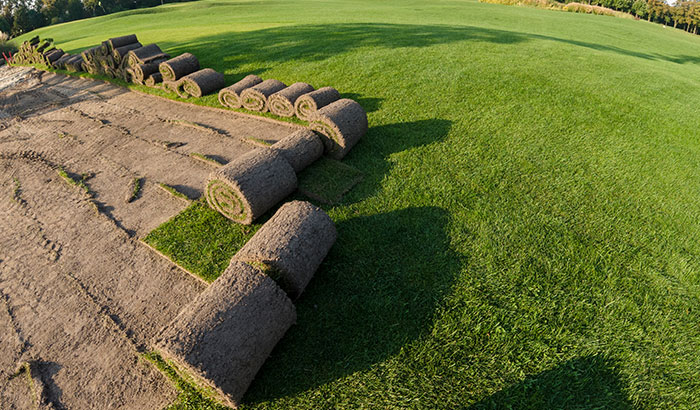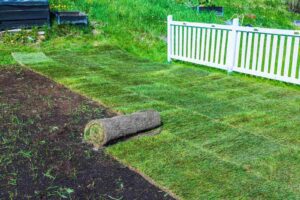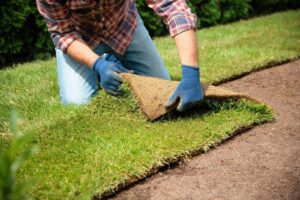If you want to turn a yard full of dirt into a lush green lawn, growing sod is a great way to do this. Of the two ways you can install a lawn, either by starting with seeds or beginning with an established plant, using sod is probably the easiest thing to do.
But is growing a lawn from sod easy to do? Most homeowners may be surprised to know just how easy it is to do. The key to growing good sod is consistency. Taking care of your growing lawn is simple so long as you follow the appropriate watering and fertilizing schedule. However, it is just as easy to forget and kill your lawn.
Before you jump into ordering a shipment of sod, here are some things you should know about the grass you will be trying to grow.
Choose the Right Grass
Before you order sod, you should understand your yard and your expectations. The climate in Utah has harsh winters and warm summers. Utah is also a desert state, so the grass you grow will require irrigation or should be drought-tolerant.
Utah’s most common sod types are Kentucky Bluegrass and a drought-tolerant mixture of Perennial Ryegrass and Tall Fescue.
If you have a big yard with lots of open space where access to water isn’t a problem, Kentucky Bluegrass will be perfect for your yard. A yeard with poor irrigation, is heavily shaded, or both may do better with the drought-tolerant mixture.
If you choose the wrong type of sod for the yard you have and want, you may find it more difficult for the grass to take root or grow.
Growing Sod Requires Consistency
When you lay sod, you must maintain a strict watering and fertilizing schedule. Neglecting this could lead to a struggling yard.
Plants can become vulnerable when they are transplanted. Although the sod you purchase rarely comes from far away—you don’t need to worry about plants adapting to your climate—the uprooting, rolling, packing, and unpacking can be hard for the grass.
When plants are vulnerable, you need to be sure to show extra special care for them.
How To Lay Sod
Laying sod is as easy as you suspect it to be. All it requires is an even ground clear of debris and large rocks and an irrigation system.
Before you lay your sod, be sure to level out your yard, as this will be difficult to do without uprooting your yard once the grass settles into place. Make sure you remove any large pieces of debris, such as garbage, sticks, and rocks.
Another thing you will want to be sure to do before you lay the sod is to install and test your irrigation system. When the sod is in place, it needs lots of water. If you forgot to install a sprinkling system, giving your sod the proper amount of water it needs to grow and take root will be difficult.
Once your yard is ready to lay sod, begin placing strips of sod one piece at a time. Don’t stress too much about having small gaps between the strips of grass you lay. Once your grass takes root, it will grow to fill any empty spaces.
Once all your grass is in place, gently go over it with a sod roller. This tool will force the roots to the ground and remove any air bubbles. This step is necessary to level out your yard and force your grass to the ground, where it can begin growing its roots.
30-day Timeline For Laying Sod
Keeping your lawn watered for the first month after installation is critical for good lawn care. Plants survive by constantly taking up water into their stems and leaves. While some plants are more water resistant than others, grasses are not a group that can go long without water.
In the first ten days, water twice a day. Once in the morning and once in the evening should be enough. In this period, your sod will be recovering from being transplanted. It won’t have had much time to grow but will begin sending roots toward the soil below in search of more water and nutrients.
Between day ten and day fifteen, fertilize your yard and reduce watering. Your sod should have had enough time to plant roots, latching themselves to the soil below. Your grass should be getting established enough to reduce watering once per day.
After the first two weeks, your grass should be ready for a little trimming. Grass becomes stimulated after it is cut and will grow faster and closer to the roots. Be sure to mow your yard with your lawn mower on the highest level possible, so you just get the tips of the grass. Reduce watering to once every other day.
Between the two and four-week points, your grass should become stable enough to reduce watering to once or twice a week or about one inch of irrigation. At this point, you should also be okay to begin treating your lawn like normal with regular mowing and more foot traffic.
The Most Important Things To Remember When Growing Sod
When you are preparing to grow grass, there are some things you should know that could make the difference between growing a lush green lawn and slowly watching your grass turn brown and die.
Plants Can Go Into Shock.
It may seem weird, but plants can go into shock. This normally happens after they experience a dramatic change, like a sudden change in climate or becoming uprooted.
Grass can go into shock, which may look like it is starting to turn brown and wilt. The best thing to do is to make sure the plant is getting enough water.
You Can Overwater Plants.
If you overwater your lawn, two things can happen. First, the ground becomes too saturated for roots to pick up water. The second is that harmful fungi will have a more fertile place to grow.
Stick to consistently watering your sod twice a day at first and reduce watering as you go.
You Can Over-fertilize Plants.
As the saying goes, too much of a good thing is too much of a good thing. Adding too much fertilizer to your sod can upset the chemical balance in the ground, making it more toxic for plants and micronutrients.
Avoid Stepping on Freshly Laid Sod if You Can.
Fresh sod is delicate. Without roots, it is a lot easier to step on and damage parts of your grass. Try to limit the amount of foot traffic on your lawn for the first ten days of growth.
Get Fresh-Grown Sod From Monarch Sod
When growing and laying sod in Utah, you want fresh sod that is already acclimated to Utah’s weather. We grow our sod locally and deliver it quickly so that you have fresh and vibrant sod that can turn into a beautiful yard.
Contact us today to learn how to get fresh sod for your yard.
toto slot











